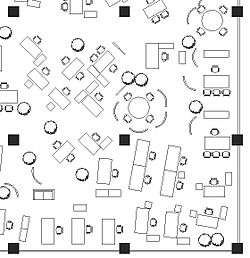Office landscape

Office landscape (German: Bürolandschaft) was an early (1950s) movement in open plan office space planning.
History
Large open office environments have existed for a long time. However, these frequently consisted of many identical rows of desks or long tables where clerks, typists, or engineers performed repetitive functions. This layout was rooted in the work of industrial engineers and efficiency experts such as Frederick Winslow Taylor and Henry Ford. The office landscape approach to space planning was pioneered by the Quickborner Team led by Eberhard and Wolfgang Schnelle based in the Hamburg suburb of Quickborn. It was intended to provide a more collaborative and humane work environment.
Social theory
The post-World War II social-democratic environment in many Northern European countries engendered an egalitarian management approach. Office landscape encouraged all levels of staff to sit together in one open floor to create a non-hierarchical environment that increased communication and collaboration.[1]
Typical designs and components
Typical designs used contemporary but conventional furniture which was available at the time. Standard desks and chairs were used, with lateral file cabinets, curved screens, and large potted plants used as visual barriers and space definers. Floor plans frequently used irregular geometry and organic circulation patterns to enhance the egalitarian nature of the plan. Many designs used slightly lower than normal occupancy density to mitigate the acoustical problems inherent in open designs.
Aftermath
Office furniture companies quickly developed panel-hung systems and other types of systems furniture which sought to provide some of the advantages of office landscape, but with slightly greater privacy, density, and storage capacity. Initially, the layouts typical of these systems imitated the irregular, organic forms of office landscape. However, they quickly degenerated into the regimented sea of cubicles common in modern offices and reminiscent of earlier Taylorism. The sea of cubicles effectively replaced office landscape by the mid-1970s.